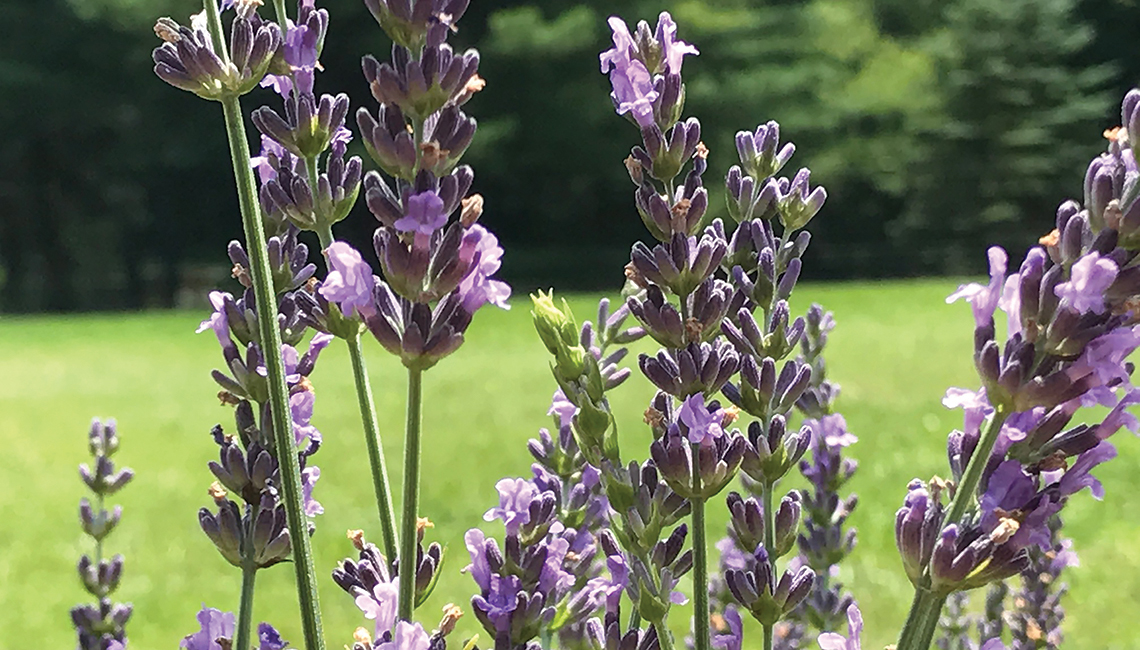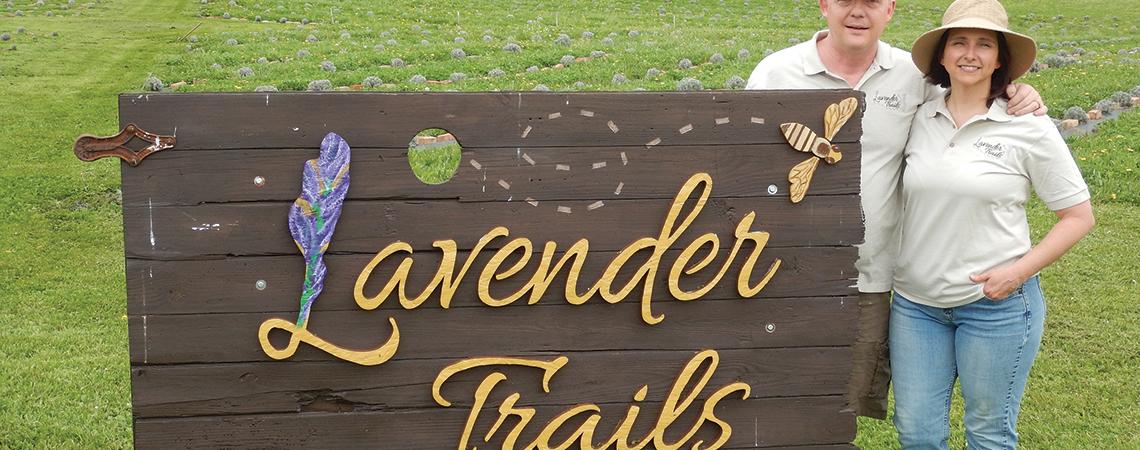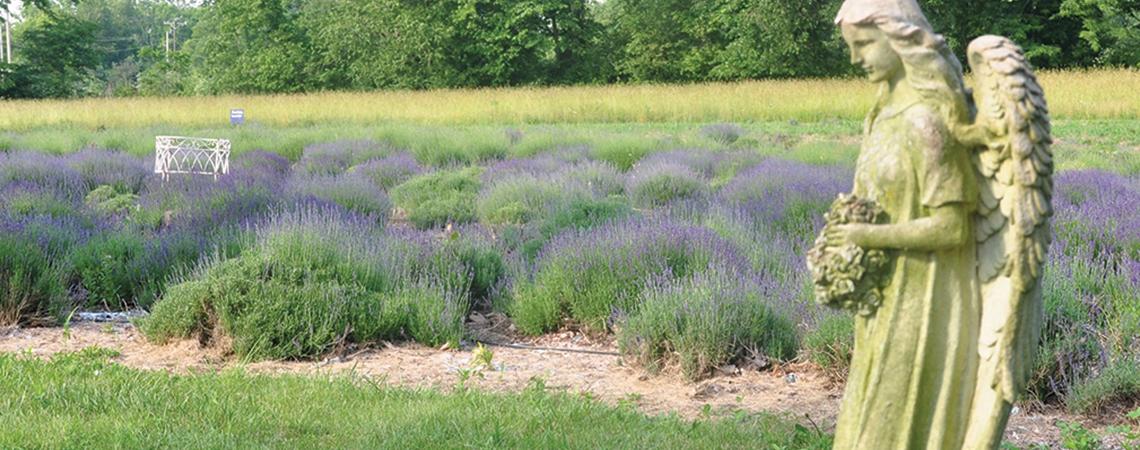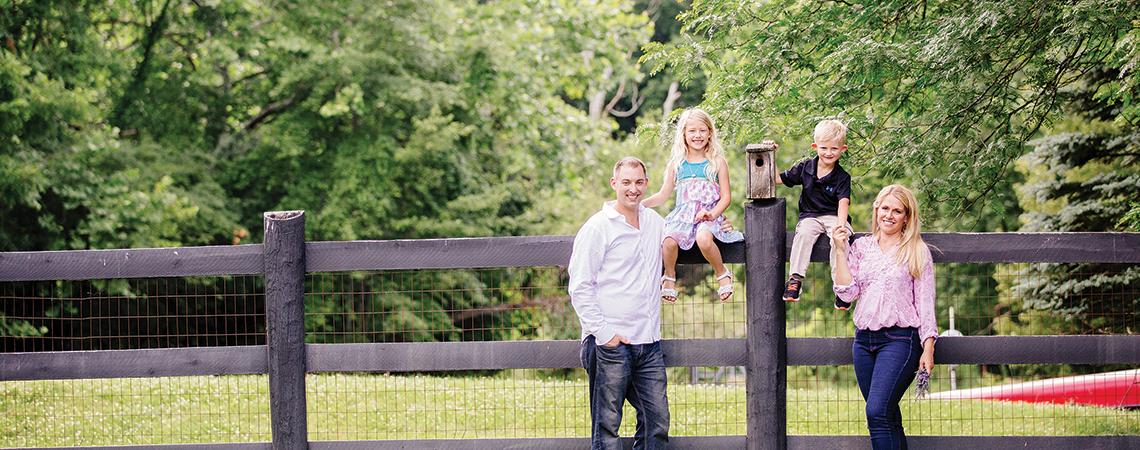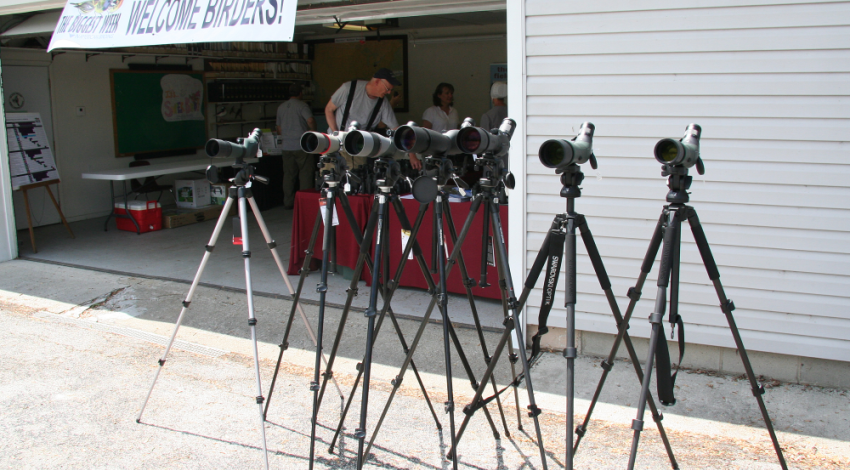Lavender has been treasured for thousands of years. In ancient Egypt, it was used in mummification; in medieval France, to perfume the air and ward off infection; and in 16th-century England, it was cherished by monarchs and mentioned by Shakespeare. Today, lavender is as popular as ever: It’s prized for its brilliant blooms, essential oil, and dried flowers and used in scores of health and beauty products — even in food.
We talked to several growers across Ohio who cultivate the sometimes-persnickety plants for U-pick stops and summer festivals, wedding bouquets, and beauty products, or simply as captivating spaces to spend a peaceful moment or two.
Jim and Amy Duxbury of Lavender Trails
Lavender Trails
The idea for a lavender farm had been rattling around in the minds of Jim and Amy Duxbury — both Orrville high school teachers, of science and English, respectively — for years. In 2018, they leased a 4-acre “brownfield” (a former industrial site) that had been a concrete dumping ground, surrounded by facilities that produced pet food, packaging, and metal fabrication.
“We took a brownfield and turned it green, creating a little island in the middle of an industrial park,” Jim says. The couple has planted 1,500 lavender plants in diamond-shaped gardens, boasting eight varieties of lavender with white, dark purple, and light purple flowers.
Though this year’s event was canceled because of the coronavirus, the couple aims to host a lavender festival each summer, inviting folks to discover the surprising sanctuary and delightful joys of Wayne County’s first lavender farm. Instead of the festival this year, they began booking daily group appointments to wander the fields for an hour at a time.
Armed with a decades-long commitment to education, Jim’s background as an environmental geologist, and a desire to “give back,” the Duxburys embrace a three-stemmed approach to their business.
Their goals include making a positive impact on the environment by creating green space, educating others about nature by attracting bees and other pollinators, and community action by helping to raise money for local schools. Their endeavor is part of “agritourism” — agriculturally related educational efforts that invite the public to join in.
“You can’t walk through a lavender field without seeing everybody smiling,” Jim says. “Lavender just makes people happy.”
Onederings Lavender Farm
More than 4,000 lavender plants — mostly English and French varieties — burst into bloom each summer on a 3-acre tract of the tree farm owned by Kim Benz and Amy Farr in southwestern Ohio. The sisters, both retired chemical engineers, established the sweetly scented space as a refuge for all.
“We created the lavender field so people could enjoy coming out and visiting. It has a boardwalk, chairs, benches to rest upon, and a fully accessible shop,” says Benz. “We invite people to wander the fields, enjoy the peacefulness, bring a picnic, and perhaps sample some lavender lemonade.”
The two are among seven siblings who were “planting things from the time we were about 6 years old,” she says. Three of the sisters purchased the farm back in the 1980s, building their homes as a bucolic place to raise their families. The idea for the lavender farm came after the death of their mom in 2008.
“We had visited gorgeous lavender farms in Oregon and found the relaxing qualities of lavender soothing. So, we decided to plant it as a way to deal with our grief and honor our mom,” Benz explains.
But lavender, originally cultivated in Mediterranean climates, can be a bit finicky in Ohio, preferring well-drained, even rocky soil. It dislikes “wet feet.”
“We had to figure out if we could grow lavender here; we didn’t want to fight nature,” Benz says.
Today, Onederings entices visitors to its fields (by reservation only during social distancing) and offers a range of products online, on-site, and at farmers markets.
Sunshine Acres Lavender Farm
Jennifer and Jeff Clarke settled on a pastoral, 7-acre farm in southwest Ohio as a peaceful place to raise their family. They added a flock of chickens, some Nigerian pygmy goats … and a 2-acre field of lush lavender.
It seemed the perfect place for a U-pick lavender destination, so they turned to social media to spread the word about their inaugural event. “The notice went viral,” says Jeff. “All of a sudden, 72,000 people had clicked that they were ‘interested.’ We lost sleep for a couple of nights, worrying about what might happen, especially since our farm is at the end of a one-lane road.”
That was in 2017, and the pick-your-own lavender sold out in two short, frenzied hours. “It was a crazy success,” says Jennifer. But the couple learned and evolved, switching to a staggered plan that works. Now, the farm is only open for special events with per-car ticketed time slots that carve out plenty of time for wandering the rows of flowers.
The Clarkes’ lavender field is also the picture-perfect setting for an annual, private event — with music from a string quartet, a glass of lavender champagne, and pick-your-own bouquets — to benefit CancerFree Kids.
Focusing on a particularly hardy variety of lavender called Phenomenal — first cultivated in 2014 by Peace Tree Farm in Bucks County, Pennsylvania — the couple is branching out with a product line of lotions, goat’s milk soap, and some unique goodies. “We make a lavender honey butter, lavender blueberry simple syrup, and lavender-infused honey,” says Jennifer.
They’re even partnering with local Two Bucks Coffee Company to add a unique floral note to that morning cup of joe with lavender-roasted ground coffee. “It’s the perfect way to greet the day,” she says.
Try Onederings’ Lavender Lemonade
Place 4 teaspoons dried and ground culinary lavender in a tea bag. Pour 8 ounces of boiling water over it. Allow it to steep 20 to 30 minutes. Let cool, and add to 2 quarts of your favorite lemonade. (Note: Be sure to use lavender labeled for culinary use.)
